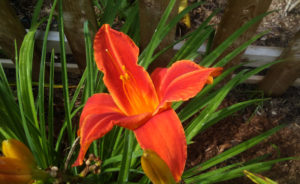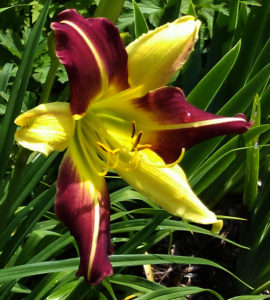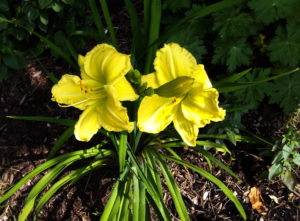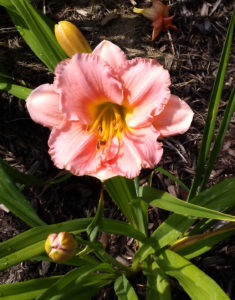Blooms for a day; memories of a life time
by Georgeanne Vyverberg –

Nearly three years ago I realized that I needed to downsize. I owned and lived on a 17-acre piece of country for nearly 40 years. The property had about five acres of gardens, which I had built during those years. Gardening is more than a hobby to me. It was the source of about half my food, but it was also food for my soul. Like most of my fellow gardeners I could always go to the garden to find solace and beauty and a closeness to the natural world. The work of a garden is how we gardeners pay for those gifts and we willingly do so.
I found a tiny house in a small village. While the house is adorable, it was the nearly half acre blank slate of a yard that beckoned me. With only the essentials of a household unpacked, I began to build gardens. It was late April…no time to lose. I became a regular at all the garden centers and was on a first name basis with some of them. Trees, shrubs, perennials were purchased and planted. My energy seemed boundless. I wanted to have all the plants I had left behind on my little farm and some I had always wanted as well. Although I had worked as a landscape gardener for nearly 10 years I never had the knack of planning a garden on paper. I just put things in and somehow the gardens took shape and had the look I wanted.

Back in my country gardens I had about a hundred daylilies, some of which I had collected myself, many given to me by gardener friends. These colorful plants became the backbone of my gardens. They begin flowering after most of the spring and early summer plants are finished, and fill in that time before fall sunflowers and phlox and asters.
Daylilies are just that. A blossom only lasts a day. Of course, there are multiple blooms on any given plant. So, in July and early August coffee cup or wine glass in hand, a daily garden tour is an absolute must. Colors ranging from the palest pinks to orange and reds and purple and even black can be found. The shapes and variations can take your breath away. These are not the plants one sees along the roadside, although those are the very ones that were used to hybridize into some 60,000 plus individuals available today.
Daylilies are native to eastern Asia. They were mentioned in the Chinese Materia Medica of 656 AD and were brought to 16th century Great Britain. Early settlers to the Americas brought them to grace their small homes. It was one such clump growing in his mother’s garden that interested a young boy, who grew up to be the botanist, Arlow Burdett Stout, who while working at the New York Botanical Society in the 1920’s, developed some 50,000 crosses, many varieties still available today.
Then there are the names. Fantastic names, silly names and many with names of people real or imagined. How about Peach Fairy, Swirling Waters, Lady Lucille or Pink Jedi—for Star Wars fans.Then there is Palace Concubine and Lusty Leland (my friend insisted these two always be planted together),Green Glitter, which does glitter in the sunlight, and another favorite Cherry Cheeks.

Also, there are the anomalies. How about a group called Creepy Crawlers, which sport petals with teeth-like edges or twisted lilies that have petals and sepals that twist upon themselves. Diabolique is one of the so called quilled varieties, wherein the petals become tube or quill like. Some have spatulate petals, and then there are my favorites, the spiders or open forms. The petals are split giving them that spidery look. There is one named the Brown Recluse, but in contrast to its name is so beautiful.

One of my gardener friends has probably 200 plus daylily specimens, and since they needed dividing she offered some of her favorites to me for my new gardens. I only needed to help her with the work of digging and separating. So, in late August we began digging what would become 65 cultivars for my newly established gardens. When working with someone who has the same passion for plants time is nonexistent and I shall treasure this daylily project forever. There is only the work and the talk of gardening, which for us relates to a life well lived. We understand one another. We see the importance of plants and gardens and the pleasure of creating something beautiful and useful as well. One of the beauties of gardening friends is that they are eager to share unusual or even rare plants. After 40 years in my country garden, while walking my garden paths there was the rich history and memory of the person who gave them to me. They were more than plants. They connected me to those now gone or far away. Mildred, who taught me everything I know about goats, gave me an unusual single white peony. When Mildred passed away in late winter one year, I looked for her peony that following spring. It never appeared. Still, the place where it had been always elicited memories of her. The golden raspberries were another gift from a friend, who was trying to get rid of them as they had turned out to be so vigorous that they were taking over his garden. They are fragile and not often seen in markets but so delicious and worth the problem. The stories are endless and so I miss my old gardens.
Although I have been in my new home for a little over a year, I have plants that I had given away to friends who knew I needed them, and one by one, many of my favorites were returned to me. While I miss other plants in my country gardens, I am beginning a new garden of memories. When I do my early morning tour and I see all those daylilies, I see my friend and I working and sharing stories of the plants and our lives. She told me recently she is thinking of moving and is happy that I have so many of her favorite daylilies and knows she can retrieve them. Gardening friends are like money in the bank.
Georgeanne has been fascinated by plants ever since a neighbor gave her some flower seeds when she was very young. The magic of watching them sprout into beautiful flowers has become a lifetime of wonderment. She lives in Honeoye Falls with her canine and feline friends and small flock of chickens and more recently a rabbit. Georgeanne’s gardening feature – The Village Gardener – will appear bi-weekly in Owl Light News.